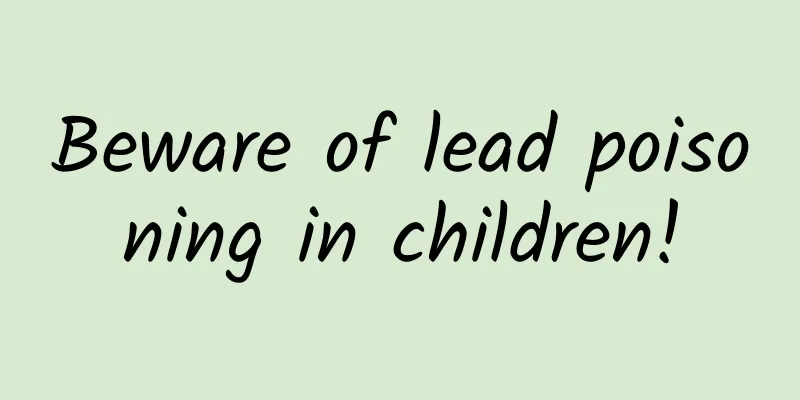Beware of lead poisoning in children!

|
In the clinic, parents often bring their babies to see the doctor for "stomach pain". The mother said that after many tests, the blood routine was just a little "anemic", the urine and stool were normal, and the B-ultrasound results were also normal. Rubbing the baby's belly and applying hot compresses did not have much effect. The baby still complained of "stomach pain" from time to time, which made the mother particularly worried. Finally, the trace element test showed: blood lead 200μg/L, which has reached the level of lead poisoning! According to the guidelines, the normal blood lead value for children aged 0-16 is <100μg/L. The "Child Lead Poisoning Guidelines" of the US CDC (National Center for Disease Control) states that if the blood lead level is greater than or equal to 100μg/L, it can be diagnosed as lead poisoning regardless of whether there are corresponding clinical symptoms, physical signs and other blood biochemical changes, and the blood lead level of children is divided into five levels: Grade I: <100 μg/L; Level II: 100 μg/L-199 μg/L; Grade III: 200 μg/L-449 μg/L; Grade IV: 450 μg/L-699 μg/L; Grade V: ≥700μg/L. What are the symptoms and hazards of high blood lead levels in children? Common symptoms of high blood lead in children are mainly related to growth and development and the nervous system: picky eating, anorexia, insomnia, frequent dreams, irritability, inattention, hyperactivity, aggressive behavior, slow reaction, memory loss, and decreased reading ability. It will also interfere with the absorption of trace elements such as calcium, iron, and zinc, leading to calcium, iron, and zinc deficiency and anemia symptoms. In severe cases, there will be slow physical growth and development, low immunity, abdominal pain, leg pain, etc.; in more serious cases, there will be coma, convulsions and other lead poisoning encephalopathy, liver and kidney damage and other systemic failure symptoms, and even death. What are the sources of lead? Lead is everywhere and enters children's bodies mainly through the digestive tract and respiratory tract and accumulates in the body. 1. Industrial waste gas and automobile exhaust. Industrial waste gas and automobile exhaust contain a large amount of lead, which will diffuse in the air and enter the human body through the respiratory tract; automobile exhaust is concentrated in the area below 1 meter above the ground, and children are the biggest victims. 2. Lead-containing paint and some daily necessities. Newly renovated rooms and new furniture, lead-containing paint can release lead-based paint particles for a long time, causing lead exposure to children. Plastic products contain a large amount of lead, such as commonly used school supplies and color printed books and teaching materials, plastic toys, furniture, etc. Some topical drugs and cosmetics contain a small amount of lead, so try to avoid contact with children. 3. Foods high in lead. Common foods include popcorn, preserved eggs, canned food and fruits. Expired and spoiled canned food has the highest risk of lead poisoning. 4. Passive smoking. Children who grow up in smoking families are ten times more likely to suffer from lead poisoning than normal children. The younger the age, the more sensitive they are to smoke lead pollution. Two years old may be the main period for children to absorb passive smoking lead. How to prevent lead poisoning in children? 1. Try not to take your children for walks or plays on roads with heavy traffic or near chemical plants. 2. Cultivate good living habits. Pay attention to cultivating children to wash their hands frequently and not to develop bad habits of biting pencil heads, fingers and other objects to prevent lead from entering the body through the digestive tract. Toys need to be cleaned and wiped frequently. 3. Provide correct guidance to avoid contact with or accidental licking of cosmetics and some medicines. 4. Do not smoke at home or in places where children are present. How to deal with lead poisoning For children with lead poisoning below 60μg/L, prevention is the priority. For grades II to III, lead-removal treatment must be carried out under the guidance of a doctor using nationally certified lead-removal foods to enable lead-poisoned children to recover as soon as possible. Patients with grades IV to V should have their blood lead levels rechecked within 48 hours. If confirmed, lead removal treatment should be given immediately, and the cause of lead infection should be investigated and intervened. |
Recommend
Can I use Chinese medicine to soak my feet during my period?
There are some things that women need to pay atte...
Is premenstrual nausea a sign of pregnancy?
Menstruation is something that every girl experie...
Can I play badminton during menstruation?
Women who have the habit of exercising are genera...
What is the normal size of the gestational sac during pregnancy?
After a woman becomes pregnant, she will have reg...
Kidney disease can actually "find" primary school students? Doctor: If you don't take it seriously, it may turn into uremia!
In daily diet Control salt and sugar Exercise pro...
Can I eat grapes during confinement? Pregnant women must know
Grapes are highly sought after because of their m...
How long to have sex after the ovulation test paper shows a strong positive
If you want to get pregnant quickly, everyone kno...
What should a 30-year-old woman eat to maintain her health?
At the age of thirty, most female friends have al...
Do ovarian cysts affect fertility?
The ovaries are very important to a woman. Only w...
Real picture of fetus at 17 weeks of pregnancy
At 17 weeks of pregnancy, the fetus is 13 cm long...
Is Lithospermum officinale effective in treating cervical erosion?
Cervical erosion is actually a gynecological prob...
What to do if you have a boil on your genitals
Women are very fragile and can easily be troubled...
What is the concentration of soda water for vaginal douche?
Nowadays, women are very particular about hygiene...
What to do if you have early pregnancy bleeding?
Normal physiological early pregnancy bleeding wil...
Lolamine drugs can be used for coronary heart disease, but are not recommended for variant angina
An elderly friend told Huazi that he occasionally...









